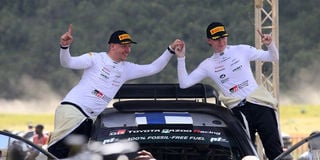Premium
Why Safari Rally winner Rovanpera will not earn prize money

Kalle Rovanpera (right) celebrates with his navigator Jonne Haltunnen after winning WRC Safari Rally in Naivasha on March 31, 2024.
What you need to know:
- For a start, there is no prize money on offer in the Safari Rally or national championship events
- Patrick Njiru at his prime was earning Sh8.5 million from BAT sponsorship annually between 1995-97
Kalle Rovanpera was awarded a wooden carving valued at Sh25,000 for winning the 2024 WRC Safari Rally, and celebrated his victory with alcohol-free champagne.
Kenyans have been wondering how one can risk his life, expend too much energy for a wooden carving, noting that it has never been disclosed how much is the prize money for the Safari compared to other local events like the Magical Kenya Open which offers the winner $425,000
(Sh55 million) from US$2.5 million (Sh325 million) kitty, Kip Keino Classic Continental Tour and city marathon races.
For a start, there is no prize money on offer in the Safari Rally or national championship events. Instead one is expected to pay between Sh15,000 to Sh50,000 entry fees. You either have old money or should seek sponsors because motorsport is all about business.
But motorsport at the highest level is like any other profession where workers are paid a monthly salary and performance bonuses. They are encouraged to seek endorsements and individual commercial sponsors.
But unlike in other professional sports, rally drivers remuneration is never disclosed to the public. It is an agreement between them and their teams. However, once in a while, drivers disclose their financial worth with the sponsors.
For example, Safaricom Mpesa Global announced a Sh20 million sponsorship for Ford driver Adrien Fourmaux to fly the Mpesa logo in the Safari and 10 other events this year.
However, Colin McRae’s move from Subaru for Ford was reportedly to have cost Ford £6 million (Sh668M) in salaries in 1999, the last publicly disclosed salary for a rally driver.
Since inception, the Safari Rally was not about money. The Safari was born at a bar in Limuru when the two gentlemen Eric Cecil and Vincent Niel decided to do a long distance event for the fun of it.
Thereafter local car franchises adopted the Safari as a marketing tool for their products and initially companies like Marshals East Africa and DT Dobie gave their workshop managers vehicles to drive in the Safari as part of marketing strategies.
But gradually drivers like Shekhar Mehta, Joginder Singh and Vic Preston Junior were identified for such missions before they were snapped by manufacturer teams who started paying them money.
So how much does a top rally driver earn without prize money? Nation Sport combed through the internet and found out that rally drivers are some of the best paid professionals.
A website (Rally Sports) revealed the salary of the driver according to them in which 2023 Safari champion Sebastien Ogier tops the list with annual pay of US$2.5 million (Sh325 million), Thierry Neuville (Sh260 million), and Sébastien Loeb (Sh195 million).
But all these remain estimates minus official communication. Patrick Njiru at his prime was earning Sh8.5 million from BAT sponsorship annually between 1995-97.
The fans also have been asking why the WRC is competed by hatch back cars and not salons.
The website explained that manufacturers rally cars to market and sell cars, and right now hatchbacks are the preferred vehicles in Europe
Hatchbacks have shorter length than sedans, which gives slightly more advantage for agility. Other than that, rally cars use compact sized cars and the majority of the compact cars sold in Europe are hatchbacks, so they use the hatchback models to promote the models to the masses.





